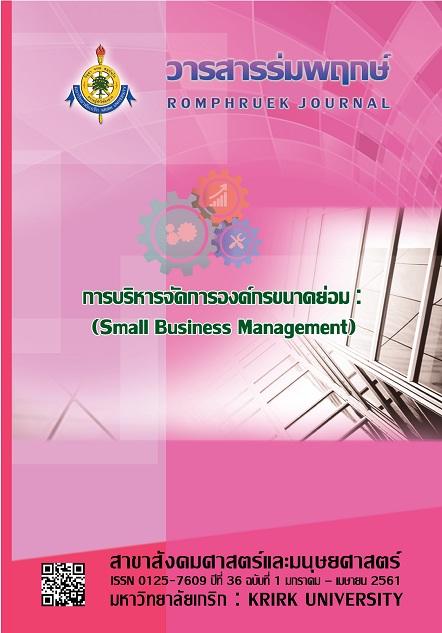An Analysis and Model Building of the Relationship between Social Quality and Happiness of Population by Using Data Mining
Main Article Content
Abstract
The social quality of the quality population has been one of the most prominent issues that made people happier and was also among researchers’ interest. However, the data analyses leading to such explanation and prediction in social quality and happiness have limitation. This research presented a new technique using data mining that give conclusion for seeking the true pattern, guideline and association hidden in those data sets to create the best social quality modeling to predict the happiness of population. This correlational research gathered the data from 944 people who were over 18 years old and lived in Chantaburi province.
The results revealed that separable variables with no partition were the best model prediction, social quality, social-economic security, social inclusion, social cohesion and social empowerment related to happiness of population in Chantaburi province. These findings highlight the decision making to build the policy to make people in Chantaburi province happy with efficient social quality.
Article Details
Every article published in the Romphruek Journal of the Humanities and Social Sciences is the opinion and point of view of the authors. Thery're not the viewpoint of Krirk University or the editored department. Any part or all of the articles for pablication must be clearly cited.
References
ตีรณ พงศ์มฆพัฒน์. (2553). นโยบายความสุข: จิต วัตถุ และความต้องการที่ไม่สิ้นสุด. กรุงเทพฯ : แปรน พริ้นติ้ง จำกัด.
รติพร ถึงฝั่ง และ รัชพันธุ์ เชยจิตร. (2558). ความมั่นคงทางเศรษฐกิจสังคมกับความสุขของประชากรในเขตกรุงเทพมหานคร.
วารสารพัฒนาสังคม, 17, 111-133.
ศูนย์วิจัยความสุขชุมชน. ผลการจัดอันดับจังหวัดแห่งความสุขของประเทศไทย : กรณีศึกษาตัวอย่างประชาชนอายุ 18 ปีขึ้นไปใน 77 จังหวัดทั่วประเทศ. (14 พฤษภาคม 2559) สืบค้นจาก http://www.maehongson.go.th/usrupl/dailyevent/march2013/ leadm3d28_doc.pdf.
สุรสิทธิ์ วชิรขจร. (2553). คุณภาพสังคมเพื่อคุณภาพประเทศไทย. กรุงเทพฯ : จรัญสนิทวงศ์การพิมพ์.
เสาวลักษม์ กิตติประภัสร์. (2553). การวัดความสุขเพื่อขับเคลื่อนการพัฒนา. ใน เอกสารประกอบการประชุมวิชาการจิตตปัญญาศึกษา ครั้งที่ 3. นครปฐม : มหาวิทยาลัยมหิดล.
สำนักงานคณะกรรมการพัฒนาการเศรษฐกิจและสังคมแห่งชาติ. ตารางสถิติผลิตภัณฑ์ภาคและจังหวัด(2547-2558).
(14 กุมภาพันธ์2560) สืบค้นจาก http://www.nesdb.go.th/main.php?filename=gross_regional.
สำนักงานคณะกรรมการพัฒนาการเศรษฐกิจและสังคมแห่งชาติ. (2560). รายงานภาวะเศรษฐกิจ ในประเทศ ปี 2560. กรุงเทพฯ : สำนักงานคณะกรรมการพัฒนาการเศรษฐกิจและสังคมแห่งชาติ.
สำนักงานพัฒนาสังคมและความมั่นคงของมนุษย์จังหวัดจันทบุรี. (2559). รายงานสถานการณ์ทางสังคมจังหวัดจันทบุรี ปี 2559. จันทบุรี : กลุ่มนโยบายและวิชาการ สำนักงานพัฒนาสังคมและความมั่นคงของมนุษย์จังหวัดจันทบุรี.
Abbott, P. (2007). Cultural Trauma Social Quality in Post-Soviet Moldova and Belarus. East European Politics and Societies, 21, 219-258.
Chapman, P., Clinton, J., Kerber, R., Khabaza, T., Reinartz, T., Shearer, C., & Wirth, R. (2000). CRISP-DM 1.0 : Step-By-Step Data Mining Guide. SPSS Inc. Retrieved From http://ftp.software.ibm.com/software/analytics/spss/support/Modeler/ Documentation/14/UserManual/CRISP-DM.pdf.
Lin, K. (2016). Social Quality and Happiness – An Analysis of the Survey Data from Three Chinese Cities. Applied Research Quality Life, 11, 23-40.
Seligman, M. E. P. (2002). Authentic Happiness : Using the New Positive Psychology to Realize Your Potential for Fulfillment. New York : Free Press.
Yamane, T. (1973). Statistics ; An Introduction Analysis. New York : Harper and Row.
Yuan, H. and Golpelwar, M. (2013). Testing Subjective Well-Being from the Perspective of Social Quality: Quantile Regression Evidence from Shanghai, China. Social Indicators Research, 113, 257-276.


